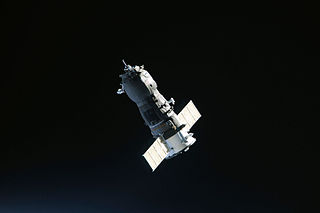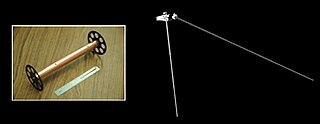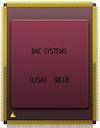
2001 Mars Odyssey is a robotic spacecraft orbiting the planet Mars. The project was developed by NASA, and contracted out to Lockheed Martin, with an expected cost for the entire mission of US$297 million. Its mission is to use spectrometers and a thermal imager to detect evidence of past or present water and ice, as well as study the planet's geology and radiation environment. The data Odyssey obtains is intended to help answer the question of whether life once existed on Mars and create a risk-assessment of the radiation that future astronauts on Mars might experience. It also acts as a relay for communications between the Curiosity rover, and previously the Mars Exploration Rovers and Phoenix lander, to Earth. The mission was named as a tribute to Arthur C. Clarke, evoking the name of his and Stanley Kubrick's 1968 film 2001: A Space Odyssey.

Uncrewed spacecraft or robotic spacecraft are spacecraft without people on board. Uncrewed spacecraft may have varying levels of autonomy from human input; they may be remote controlled, remote guided or autonomous: they have a pre-programmed list of operations, which they will execute unless otherwise instructed. A robotic spacecraft for scientific measurements is often called a space probe or space observatory.
The PowerPC 7xx is a family of third generation 32-bit PowerPC microprocessors designed and manufactured by IBM and Motorola. This family is called the PowerPC G3 by Apple Computer, which introduced it on November 10, 1997. The term "PowerPC G3" is often, and incorrectly, imagined to be a microprocessor when in fact a number of microprocessors from different vendors have been used. Such designations were applied to Mac computers such as the PowerBook G3, the multicolored iMacs, iBooks and several desktops, including both the Beige and Blue and White Power Macintosh G3s. The low power requirements and small size made the processors ideal for laptops and the name lived out its last days at Apple in the iBook.
MIL-STD-1750A or 1750A is the formal definition of a 16-bit computer instruction set architecture (ISA), including both required and optional components, as described by the military standard document MIL-STD-1750A (1980). Since August 1996, it has been inactive for new designs.

The Mars Climate Orbiter was a robotic space probe launched by NASA on December 11, 1998, to study the Martian climate, Martian atmosphere, and surface changes and to act as the communications relay in the Mars Surveyor '98 program for Mars Polar Lander. However, on September 23, 1999, communication with the spacecraft was permanently lost as it went into orbital insertion. The spacecraft encountered Mars on a trajectory that brought it too close to the planet, and it was either destroyed in the atmosphere or escaped the planet's vicinity and entered an orbit around the Sun. An investigation attributed the failure to a measurement mismatch between two measurement systems: SI units (metric) by NASA and US customary units by spacecraft builder Lockheed Martin.

Mars Science Laboratory (MSL) is a robotic space probe mission to Mars launched by NASA on November 26, 2011, which successfully landed Curiosity, a Mars rover, in Gale Crater on August 6, 2012. The overall objectives include investigating Mars' habitability, studying its climate and geology, and collecting data for a human mission to Mars. The rover carries a variety of scientific instruments designed by an international team.
Radiation hardening is the process of making electronic components and circuits resistant to damage or malfunction caused by high levels of ionizing radiation, especially for environments in outer space, around nuclear reactors and particle accelerators, or during nuclear accidents or nuclear warfare.
The RAD750 is a radiation-hardened single-board computer manufactured by BAE Systems Electronics, Intelligence & Support. The successor of the RAD6000, the RAD750 is for use in high-radiation environments experienced on board satellites and spacecraft. The RAD750 was released in 2001, with the first units launched into space in 2005.

STEREO is a solar observation mission. Two nearly identical spacecraft were launched in 2006 into orbits around the Sun that cause them to respectively pull farther ahead of and fall gradually behind the Earth. This enabled stereoscopic imaging of the Sun and solar phenomena, such as coronal mass ejections.
The Mongoose-V 32-bit microprocessor for spacecraft onboard computer applications is a radiation-hardened and expanded 10–15 MHz version of the MIPS R3000 CPU. Mongoose-V was developed by Synova of Melbourne, Florida, USA, with support from the NASA Goddard Space Flight Center.

The following outline is provided as an overview of and topical guide to space exploration.
The embedded computer systems onboard Mars rovers are designed to withstand high radiation levels and large temperature changes in space. For this reason their computational resources are limited compared to systems commonly used on Earth.

The DF-224 is a space-qualified computer used in space missions from the 1980s. It was built by Rockwell Autonetics. As with many spacecraft computers, the design is very redundant, since servicing in space is at best difficult and often impossible. The configuration had three CPUs, one active and two spares. The main memory consisted of six memory units, each with 8K 24-bit words of plated wire memory, with up to 48K words total. Four memory modules could be powered up at one time, resulting in a maximum of 32K words of available memory, though some applications such as the Hubble Space Telescope used fewer memory banks to allow for graceful failure modes. There were three I/O processors, one operational and two backups. The power supply consisted of 6 independent power converters, with overlapping coverage of the operating functions. The processor used fixed-point arithmetic with a two's complement format.
The NASA Standard Spacecraft Computer-1 (NSSC-1) is a computer developed as a standard component for the MultiMission Modular Spacecraft at the Goddard Space Flight Center (GSFC) in 1974. The basic spacecraft was built of standardized components and modules, for cost reduction. The computer had 18 bit wide core memory or plated wire memory; up to 64 k. 18 bits was chosen because it gave more accuracy (x4) for data over a 16 bit machine. Floating point arithmetic was not supported.

Curiosity is a car-sized Mars rover exploring Gale crater and Mount Sharp on Mars as part of NASA's Mars Science Laboratory (MSL) mission. Curiosity was launched from Cape Canaveral (CCAFS) on November 26, 2011, at 15:02:00 UTC and landed on Aeolis Palus inside Gale crater on Mars on August 6, 2012, 05:17:57 UTC. The Bradbury Landing site was less than 2.4 km (1.5 mi) from the center of the rover's touchdown target after a 560 million km (350 million mi) journey.
The RAD5500 is a radiation-hardened 64-bit processor core design created by BAE Systems Electronics, Intelligence & Support based on the PowerPC e5500 designed by IBM and Freescale Semiconductor. Successor of the RAD750, the RAD5500 processor platform is for use in high radiation environments experienced on board satellites and spacecraft.

Waves is an experiment on the Juno spacecraft for studying radio and plasma waves. It is part of a collection of various types of instruments and experiments on the spacecraft; Waves is oriented towards understanding fields and particles in the Jupiter's magnetosphere. Waves is on board the uncrewed Juno spacecraft, which was launched in 2011 and arrived at Jupiter in the summer of 2016. The major focus of study for Waves is Jupiter's magnetosphere, which if could be seen from Earth would be about twice the size of a full moon. The magnetosphere has a tear drop shape, and that tail extends away from the Sun by at least 5 AU. The Waves instrument is designed to help understand the interaction between Jupiter's atmosphere, its magnetic field, its magnetosphere, and to understand Jupiter's auroras. It is designed to detect radio frequencies from 50 Hz up to 40,000,000 Hz (40 MHz), and magnetic fields from 50 Hz to 20,000 Hz (20 kHz). It has two main sensors: a dipole antenna and a magnetic search coil. The dipole antenna has two whip antennas that extend 2.8 meters and are attached to the main body of the spacecraft. This sensor has been compared to a rabbit-ear TV antenna. The search coil is overall a Mu-metal rod 15 cm (6 in) in length with a fine copper wire wound 10,000 times around it. There are also two frequency receivers that each cover certain bands. Data handling is done by two radiation-hardened systems on a chip. The data handling units are located inside the Juno Radiation Vault. Waves is allocated 410 Mbits of data per science orbit.

Juno Radiation Vault is a compartment inside the Juno spacecraft that houses much of the probe's electronics and computers, and is intended to offer increased protection of radiation to the contents as the spacecraft endures the radiation environment at planet Jupiter. The Juno Radiation Vault is roughly a cube, with walls made of 1 cm thick titanium metal, and each side having an area of about a square meter. The vault weighs about 200 kg (500 lbs). Inside the vault are the main command and data handling and power control boxes, along with 20 other electronic boxes. The vault should reduce the radiation exposure by about 800 times, as the spacecraft is exposed to an anticipated 20 million rads of radiation It does not stop all radiation, but significantly reduces it in order to limit damage to the spacecraft's electronics.










